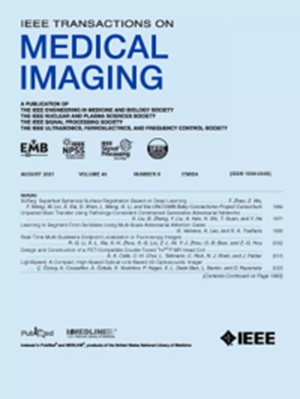基于子空间生成模型学习后验分布的无监督脑损伤分割。
IF 9.8
1区 医学
Q1 COMPUTER SCIENCE, INTERDISCIPLINARY APPLICATIONS
引用次数: 0
摘要
无监督脑损伤分割侧重于从健康受试者的图像中学习规范分布,对病变标记数据的依赖性较小,因此表现出更好的泛化能力。如果将图像像素作为相关随机变量来捕获空间依赖性,那么学习图像规范分布的一个基本挑战在于高维性。在这项研究中,我们提出了一种基于子空间的深度生成模型来学习后验正态分布。具体来说,我们使用概率子空间模型来捕获健康受试者脑图像的空间强度分布和空间结构分布。这些模型通过将子空间系数作为随机变量,基函数为从训练数据中学习到的特征图像和特征密度函数,有效地捕获了先验的空间强度和空间结构变化。然后将这些先验分布转换为后验分布,分别使用基于子空间的生成模型和子空间辅助贝叶斯分析,包括给定图像的后验正态分布和后验病变分布。最后,采用无监督融合分类器结合后验特征和似然特征进行病灶分割。该方法已在模拟和真实病变数据(包括肿瘤、多发性硬化症和中风)上进行了评估,显示出优于最先进方法的分割准确性和鲁棒性。我们提出的方法有望在临床应用中增强无监督的脑损伤描述。本文章由计算机程序翻译,如有差异,请以英文原文为准。
Unsupervised Brain Lesion Segmentation Using Posterior Distributions Learned by Subspace-based Generative Model.
Unsupervised brain lesion segmentation, focusing on learning normative distributions from images of healthy subjects, are less dependent on lesion-labeled data, thus exhibiting better generalization capabilities. A fundamental challenge in learning normative distributions of images lies in the high dimensionality if image pixels are treated as correlated random variables to capture spatial dependence. In this study, we proposed a subspace-based deep generative model to learn the posterior normal distributions. Specifically, we used probabilistic subspace models to capture spatial-intensity distributions and spatial-structure distributions of brain images from healthy subjects. These models captured prior spatial-intensity and spatial-structure variations effectively by treating the subspace coefficients as random variables with basis functions being the eigen-images and eigen-density functions learned from the training data. These prior distributions were then converted to posterior distributions, including both the posterior normal and posterior lesion distributions for a given image using the subspace-based generative model and subspace-assisted Bayesian analysis, respectively. Finally, an unsupervised fusion classifier was used to combine the posterior and likelihood features for lesion segmentation. The proposed method has been evaluated on simulated and real lesion data, including tumor, multiple sclerosis, and stroke, demonstrating superior segmentation accuracy and robustness over the state-of-the-art methods. Our proposed method holds promise for enhancing unsupervised brain lesion delineation in clinical applications.
求助全文
通过发布文献求助,成功后即可免费获取论文全文。
去求助
来源期刊

IEEE Transactions on Medical Imaging
医学-成像科学与照相技术
CiteScore
21.80
自引率
5.70%
发文量
637
审稿时长
5.6 months
期刊介绍:
The IEEE Transactions on Medical Imaging (T-MI) is a journal that welcomes the submission of manuscripts focusing on various aspects of medical imaging. The journal encourages the exploration of body structure, morphology, and function through different imaging techniques, including ultrasound, X-rays, magnetic resonance, radionuclides, microwaves, and optical methods. It also promotes contributions related to cell and molecular imaging, as well as all forms of microscopy.
T-MI publishes original research papers that cover a wide range of topics, including but not limited to novel acquisition techniques, medical image processing and analysis, visualization and performance, pattern recognition, machine learning, and other related methods. The journal particularly encourages highly technical studies that offer new perspectives. By emphasizing the unification of medicine, biology, and imaging, T-MI seeks to bridge the gap between instrumentation, hardware, software, mathematics, physics, biology, and medicine by introducing new analysis methods.
While the journal welcomes strong application papers that describe novel methods, it directs papers that focus solely on important applications using medically adopted or well-established methods without significant innovation in methodology to other journals. T-MI is indexed in Pubmed® and Medline®, which are products of the United States National Library of Medicine.
 求助内容:
求助内容: 应助结果提醒方式:
应助结果提醒方式:


